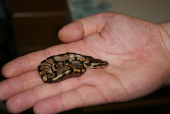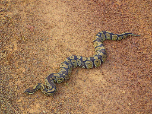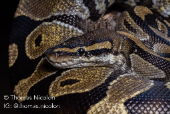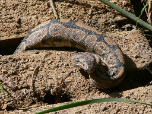|
Ball Python (Python regius)
Description: The ball python is black, or albino and dark brown with light brown blotches on the back and sides. Its white or cream belly is scattered with black markings. It is a stocky snake with a relatively small head and smooth scales. It reaches a maximum adult length of 6 feet. Males typically measure eight to ten subcaudal scales, and females typically measure two to four subcaudal scales. Females reach an average snout-to-vent length of 45+3/4 inches, a 1+3/4 inches long jaw, an 3+7/16 inches long tail and a maximum weight of 3 lb 9.7 oz. Males are smaller with an average snout-to-vent length of 43+13/16 inches, a 1+23/32 inches long jaw, an 3+3/8 inches long tail and a maximum weight of 3 lb 7.1 oz. Both sexes have pelvic spurs on both sides of the vent. During copulation, males use these spurs for gripping females. Males tend to have larger spurs, and sex is best determined by manual eversion of the male hemipenes or inserting a probe into the cloaca to check the presence of an inverted hemipenis.
Habitat: It prefers grasslands, savannas, and sparsely wooded areas.
Range: Introduced into the U.S throughout several states. The ball python is native to west Sub Saharan Africa from Senegal, Mali, Guinea-Bissau, Guinea, Sierra Leone, Liberia, Ivory Coast, Ghana, Benin, and Nigeria through Cameroon, Chad, and the Central African Republic to Sudan and Uganda.
Diet: The diet of the ball python in the wild consists mostly of small mammals and birds. Young ball pythons of less than 28 inches prey foremost on small birds. Ball pythons longer than 39 inches prey foremost on small mammals. Males prey more frequently on birds, and females more frequently on mammals. Rodents make up a large percentage of the diet; Gambian pouched rats, black rats, rufous-nosed rats, shaggy rats, and striped grass mice are among the species consumed.
Reproduction: Females are oviparous and lay three to 11 rather large, leathery eggs. The eggs hatch after 55 to 60 days. Young male pythons reach sexual maturity at 11–18 months, and females at 20–36 months. Age is only one factor in determining sexual maturity and the ability to breed; weight is the second factor. Males breed at 21 oz. or more, but in captivity are often not bred until they are 28 oz., although in captivity, some males have been known to begin breeding at 11–14 oz. Females breed in the wild at weights as low as 28 oz. though 42 oz. or more in weight is most common; in captivity, breeders generally wait until they are no less than 53 oz. Parental care of the eggs ends once they hatch, and the female leaves the offspring to fend for themselves
Status: This species is widespread and remains common at least in Togo, but continues to be subject to high levels of exploitation across its range to the extent that concern has been raised about the prospects for this snake's long-term survival in West Africa, which represents the major part of its range. While there has been no systematic research into rates of decline, and an assumption that this may have exceeded 30% over a three-generation period is considered to be overly-precautionary based on the available information, declines have been reported in most West African range states, there are no mechanisms in place to ensure that harvesting is sustainable and no systematic monitoring, and both regulation of commercial trade and enforcement of existing restrictions on harvesting are considered inadequate. This species is consequently listed as Near Threatened on the basis that this species may be close to qualifying for a threatened listing under criterion A based on either recent rates of decline or likely future declines, and research is required to ensure the species does not warrant listing in a more threatened category in future. Improved management of harvests to ensure their sustainability is required.
»» Kingdom: Animalia - Animals
»» Phylum: Chordata - Chordates
»» Subphylum: Vertebrata - Vertebrates
»» Class: Reptilia - Reptiles
»» Order: Squamata - Scaled Reptiles
»» Suborder: Serpentes
»» Superfamily: Pythonoidea
»» Family: Pythonidae - Pythons
»» Genus: Python
»» Species: Python regius - Ball Python
»» Subspecies: None
This article uses material from the Wikipedia article "Ball Python", which is released under the Creative Commons Attribution-Share-Alike License 3.0. Content may have been omitted from the original, but no content has been changed or extended.
|
|








